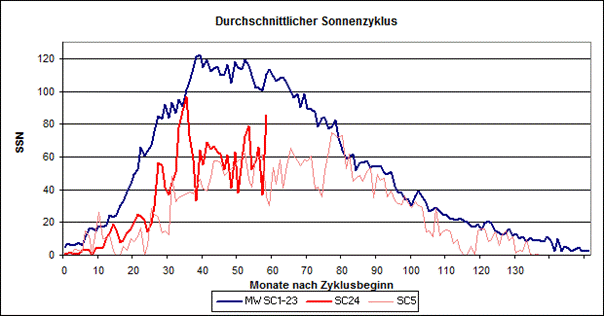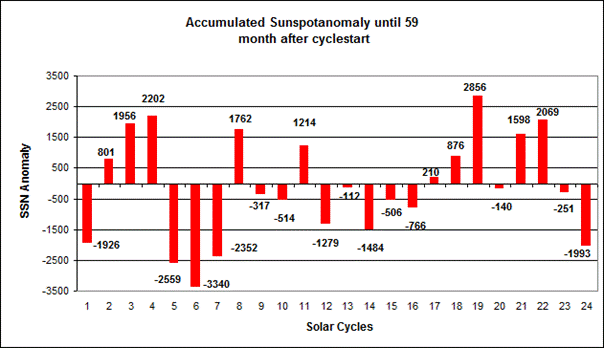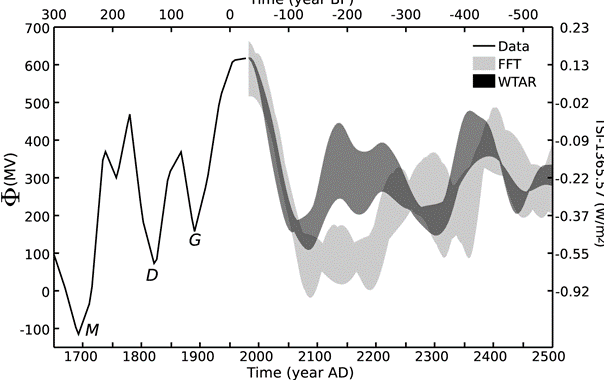The Sun in October 2013 – Minimum lies ahead
By Frank Bosse and Fritz Vahrenholt
(Translated by P Gosselin)
In October 2013 there was a considerable rise in solar activity as the sunspot number (SSN) climbed to 85.6. That’s 77% of the mean value reached at this time into a solar cycle since 1750. The following diagram shows the current situation:

SSN versus months since the start of the cycle
October 2013 deviates significantly from solar cycle number 5. However we continue to believe that SC 24 will be similar to SC 5. Just how large the uncertainties of the correct description of the 5th cycle is shown by a recently published paper by Rainer Arlt of the Leibniz Institute Potsdam and Ilya Usoskin of the Finnish University of Oulo, who after examining the solar cycles between 1750 und 1850 reached the conclusion that the sunspot count should be lowered by 20%. SC 24 shown by the red curve is, however, still very much below average of SC 1-23, let alone well below the large cycles of the solar maximums from 1940 – 1990.
Also in October 2013 mainly the southern hemisphere (SH) of our sun was active. In a comparison of the cycles with each other (here the SSN anomaly thus far up to the current cycle month) we see that the accumulated sunspot number is between SC5 and SC 14:

Current cycle indicate we are entering a Dalton-like minimum
In a recent publication in Space Science Reviews (2013), renowned solar scientists Ken McCracken, Juerg Beer, Friedhelm Steinhilber and Jose Abreu studied the solar minimums over the last 9300 years. Based on measurements of beryllium and carbon isotopes as indicators for the intensity of cosmic rays, which are modulated by solar activity, the scientists arrived at the result that the minimum of 2007 to 2009 had similar characteristics as the minimums occurring during the time of the Dalton Minimums of 1780 to 1820. They discovered a 208-year periodicity (Suess-de Vries) of a grand solar minimum in the past. Therefore they anticipate in the near future the events of a Dalton Minimum, but not a Maunder Minimum.
Lockwood sees elevated chance of a Maunder-like minimum
Another established solar scientist, Prof. Michael Lockwood of the University of Reading, has pointed out that solar activity since the end of the last century has diminished more strongly than it ever has in all the earlier times of the last 9000 years. Lockwood found 24 solar minimum in the last 9000 years, and nowhere did solar activity drop so strongly as it has in the current period. He now sees the probability of another Maunder Minimums at 25- 30%. Just a few years ago he said the probability of a Maunder Minimum re-occurring was 8%. Consequently Lockwood: “We found a significant relationship between the occurrence of cold winters in Europe and solar activity.“ The probable mechanism is the change in the solar UV radiation, which has an influence of the temperature gradient, ozone formation, and the winds in the stratosphere. This in turn disrupts the Jetstream in the northern hemisphere, leads to blocking weather patterns, and to easterly winds that lead to cold spells.
Already in our September report 2013 concerning the publication by Ermolli et al we pointed to a much more strongly variable UV radiation within a solar cycle then what is observed in the overall total radiation (factor 2-6). Weaker solar cycles have a considerably weaker UV radiation and lead to cold periods in the northern hemisphere. Unfortunately the measurements can no longer be continued because the SORCE satellite, which measures the radiation of the sun above the atmosphere, has stopped functioning because of battery damage, and so the cold winters that lie ahead will have to be endured without satellite UV measurements.
And we introduce a third publication. In it Friedrich Steinhilber and Jürg Beer are venturing a look at the next 500 years using two different methods. Here, phi is a measure of solar activity. M marks the Maunder Minimum, D the Dalton Minimum and G the weaker Gleisberg Minimum of 1900:

====================================
Other reading: wsj.com/news/8.





No mention of Livingston and Penn, bummer. They’re watching a long term cooling of sunspots that may be involved in things like the Maunder Minimum.
[…] is a longer discussion of the issue at The No Tricks Zone, where the above introduction of this paper’s abstract was […]
Typo? Text says “SC 24 shown by the blue curve,” but the curve labeled “SC24” looks red on my screen. Average of cycles 1 – 23 is blue.
Good work; thank you.
Thanks fixed
Regarding physicist Mike Lockwood’s study, referenced above:
“When the Sun’s magnetic output is low, winters in Europe tend to be cooler than average – whereas higher output corresponds to warmer winters. That is the conclusion of a new study by physicists in the UK and Germany that looked at the relationship between winter temperatures in England and the strength of the Sun’s magnetic emissions over the last 350 years. The group predicts that, global warming notwithstanding, Europe is likely to continue to experience cold winters for many years to come. ”
http://physicsworld.com/cws/article/news/2010/apr/14/sun-blamed-for-europes-colder-winters
[…] German Scientists: Solar Cycle 24 Points To Dalton Or Maunder-Like Minimum, Boding Ill For A Climate… […]
The month(s) during the solar cycle when the 12-month mean of monthly average sunspot numbers reaches minimum.
[…] https://notrickszone.com/2013/11/11/german-scientists-solar-cycle-24-points-to-dalton-or-maunder-like… […]
The headline’s English is confused. A Dalton or Maunder-like minimum bodes _well_ for global cooling; it bodes _ill_ for things that suffer during global cooling, like farming, or the IPCC.
Dr. Theodor Landscheidt did much research on solar cycles, but subsequent efforts by Geoff Sharp may have determined why the sun has declined in cycle 24. Website landscheidt.info has his theory defined in much detail, and appears to be quite credible. Couple that with the lessened Extreme Ultra Violet radiation and the Henrik Svensmark theories on high energy cosmic particles allowing for more cloud generation, the theories, taken together, create a very compelling argument to be further investigated.